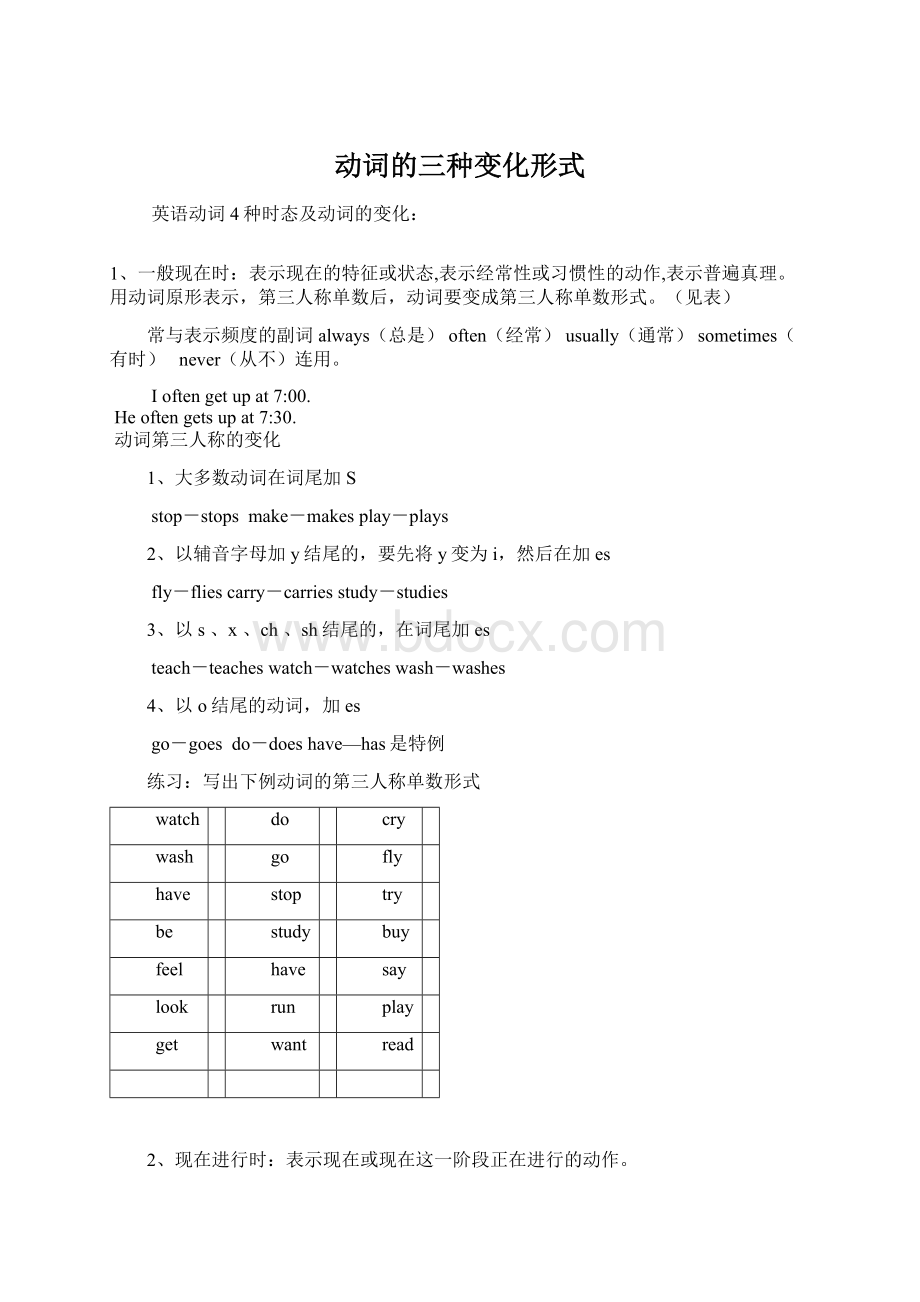动词的三种变化形式.docx
《动词的三种变化形式.docx》由会员分享,可在线阅读,更多相关《动词的三种变化形式.docx(17页珍藏版)》请在冰豆网上搜索。

动词的三种变化形式
英语动词4种时态及动词的变化:
1、一般现在时:
表示现在的特征或状态,表示经常性或习惯性的动作,表示普遍真理。
用动词原形表示,第三人称单数后,动词要变成第三人称单数形式。
(见表)
常与表示频度的副词always(总是)often(经常)usually(通常)sometimes(有时)never(从不)连用。
Ioftengetupat7:
00.
Heoftengetsupat7:
30.
动词第三人称的变化
1、大多数动词在词尾加S
stop-stopsmake-makesplay-plays
2、以辅音字母加y结尾的,要先将y变为i,然后在加es
fly-fliescarry-carriesstudy-studies
3、以s、x、ch、sh结尾的,在词尾加es
teach-teacheswatch-watcheswash-washes
4、以o结尾的动词,加es
go-goesdo-doeshave—has是特例
练习:
写出下例动词的第三人称单数形式
watch
do
cry
wash
go
fly
have
stop
try
be
study
buy
feel
have
say
look
run
play
get
want
read
2、现在进行时:
表示现在或现在这一阶段正在进行的动作。
常与now、look、listen等词连用。
表示形式:
be(am/is/are)+动词ing
Whatareyoudoing?
Iamreadingabook.
Whatishedoing?
Heissinging.
动词现在分词构成规则:
①一般的直接在后面加上ing
do--doinggo--goingwork--working
②以不发音字母e结尾的动词,要先去e再加ing,如
have__havingwrite__writingmake__making
③双写最后一个字母再加ing:
stop__stoppingsit__sittingget__getting
skip__skippinghop__hoppingcut__cutting
shop__shoppinghit__hittingput__putting
swim__swimmingrun__runningjog__jogging
forget__forgettingtravel__travellingspit__spitting
What’sAnnedoing?
安在做什么?
She’sskipping.她在跳绳。
Whataretheydoing?
他们在做什么?
Theyareplayingbasketball.他们在打篮球。
What’syourhobby?
你的爱好是什么?
Myhobbyistakingphotos.我的爱好是摄影。
Ilikeswimming.我喜欢游泳。
Plantingtreesisgoodforus.
练习:
写出下例动词的现在分词形式
原形
现在分词
原形
现在分词
jump
swim
walk
cycle
cook
make
play
write
fly
drive
wash
cook
look
watch
put
read
skip
get
draw
dance
have
listen
drink
talk
spit
brush
sweep
sleep
skip
sit
begin
get
put
jog
do
run
3、一般将来时:
常与表示将来的时间连用,如:
tomorrow,nextweek,nextyear等,表示将要发生的动作或情况。
三种形式:
shall+动词原形(shall只能用于第一人称I、we)
will+动词原形(will用于所有人称)
begoingto+动词原形/地点(表示打算干什么/准备去某地)
Whatareyougoingtodotomorrow?
I’mgoingtorideahorse.
WhatwillyoudonextSunday?
Iwillgoshopping.
Shallwegotothebeach?
Ok!
Let’sgo.
4、一般过去时:
经常与表示过去的时间连用,如:
yesterday,lastnight,longlongago等,表示过去某时发生的动作或情况。
动词要用动词的过去式。
如:
Whowasfirst?
Kenwasfirst.
Wherewereyouyesterday?
Iwasathome.
Whatdidyoudoyesterday?
Iwenttoschool
动词的过去式
Whatdidyoudo?
你们做了什么?
Wetookpictures.我们拍了照。
Whatdidyoudoduringtheholiday假期期间你做了什么?
Iwrotealittlestorybook.我写了一本小故事。
1、动词原形与特殊过去式
原形
过去式
原形
过去式
原形
过去式
am/is
was
get
got
give
gave
are
were
let
let
run
ran
do
did
put
put
sing
sang
come
came
read
read
sit
sat
go
went
tell
told
begin
began
see
saw
make
made
drink
drank
eat
ate
meet
met
know
knew
write
wrote
can
could
teach
taught
sit
sat
have
had
buy
bought
say
said
hear
heard
bring
brought
take
took
feel
felt
think
thought
stand
stood
fly
flew
find
found
2、动词原形和规则动词过去式的变化
①一般直接在动词的后面加ed
work--workedlearn--learnedclean--cleaned
②以e结尾的动词直接加d
live--liveddance--danceduse--used
③以辅音字母加y结尾的动词要改y为i再加ed
study–studiedcarry–carriedworry–worried(注意play,stay不是辅音字母加y,所以不属于此类)
④双写最后一个字母再加ed
stop–stoppedtravel–travelledjog–jogged
练习:
把下例动词的过去式
原形
过去式
原形
过去式
原形
过去式
answer
close
try
clean
dance
fly
stop
walk
talk
live
jump
call
ask
cook
liked
listen
look
play
study
travel
travelled
try
watch
want
work
do
go
have
see
is/am
are
come
eat
read
形容词比较级的用法
常见句式:
1.A+be+形容词比较级+than+B
意思为“A比B更……”
如:
Thistreeis(alittle)tallerthanthatone.
这棵树比那棵树高(一点儿)。
Myruleris(much)longerthanyours.
我的尺子比你的尺子长(得多)。
注意:
在含有连词than的比较级中,前后的比较对象必须是同类事
物之间的比较。
very,quite,too,enough一般只能修饰原级,不能修饰比较级。
2.“become+形容词比较级+and+形容词比较级”是“变得越来越……”的意思,and连接同一个形容词的比较级。
如:
Itbecomeswarmerandwarmerwhenspringcomes.
Ourschoolisbecomingmoreandmorebeautiful.
我们的学校变得越来越美丽。
形容词最高级的用法
形容词最高级形式主要用来表示三者或三者以上人或事物的比较,表示“最……”的意思。
句子中有表示范围的词或短语。
如:
ofthethree,inourclass等等。
如:
Heisthetallestinourclass.他在我们班里是最高的。
FairyTaleisthemostinterestingofall.
注意:
形容词最高级前一定要有定冠词the.
形容词的比较级和最高级的构成规则
1、单音节比较级和最高级的构成规则
1.一般情况下,比较级在后面加-er,最高级在后面加-est;
small→smaller→smallest
short→shorter→shortest
2.在重读闭音节(即:
辅音+元音+辅音)中,先双写末尾的辅音字母,比较级加-er,最高级加-est;
big→bigger→biggest
hot→hotter→hottest
3.以不发音e结尾的单音节词,比较在原级后加-r,最高级在原级后加-st;
large→larger→largest
nice→nicer→nicest
4.以“辅音字母+y”结尾的双音节词,把y改为i,比较级加-er,最高级加-est;
easy-→easier-→easiest
heavy-→heavier-→heaviest
二、多音节词比较级在前面加more,最高级在前面加most;
beautiful→morebeautiful→mostbeautiful
different→moredifferent→mostdifferent
三、不规则变化
good/well—better--bestbad/ill—worse—worst
many/much—more—mostlittle/few—less—least
练习
一、写出下例单音节形容词比较级和最高级
原级
比较级
最高级
原级
比较级
最高级
strong
big
tall
fat
short
thin
small
hot
easy
early
cheap
late
long
nice
young
happy
thick
dirty
new
old
二、多音节形容词比较级和最高级
原级
比较级
最高级
tired
moretired
mosttired
interesting
difficult
delicious
beautiful
careful
expensive
lovely
三、用适当形式填空:
1.Bobis_________(young)thanFred. but___________(tall)than Fred.
2.Whichis_________(heavy),aduckorachicken?
3.Janeismuch_______(short)thanSally.Sheisalsothe_______(short)girlintheclass.
4.AnniesaysSallyisthe________(kind)personintheworld.
5.Heisoneofthe_________________(friendly)peopleintheclass,Ithink.
6.Adictionaryismuch____________________(expensive)thanastory-book.
7.Anorangeisalittle______(big)thananapple,butmuch________(small)thana watermelon.
8.TheChangjiangRiveristhe_______(long)riverinChina.
9.Sueis___________(beautiful)thanhersister.
10.--Annieplaysthepianovery___________(well).
--Sueplaysit_____(well)thanAnnie.
--AndSallyplaysitthe__________(well).
11.Saturdayismy____________(busy)dayinaweek.
12.Hermotherisgetting____________(fat)and________(fat).
13.Ithinkit'stooexpensive.I'dlikea_____________(cheap)one.
14.Hecomestoschoolmuch____________(early)thanI.
15.Mostofthestudentsthinkalionismuch___________________(dangerous)thanabearanditis_______________________(dangerous)animalintheworld.
16.Itismuch________(hot)todaythanyesterday.
人称代词与物主代词
一、人称代词
Whosekeyisthis?
Isthisyourkey?
这是谁的钥匙?
No,it’snotmine.不是我的。
我
你
他
她
它
我们
他们
主格
I
you
he
she
it
we
they
宾格
me
you
him
her
it
us
them
物主代词
我的
你的
他的
她的
它的
我们的
他们的
形容词性
my
your
his
her
its
our
their
名词性
mine
yours
his
hers
its
ours
theirs
2、反身代词
myself我自己ourselves我们自己
yourself你自己yourselves你们自己
himself他自己herself她自己itself它自己
themselves他们自己
练习
一、根据要求变化
We______(宾格)its_______(名词性物主代词)
She_______(宾格)their_______(名词性物主代词)
it________(宾格)my__________(名词性物主代词)
him________(主格)they________(形容词性物主代词)
them________(主格)he________(形容词性物主代词)
you________(主格)our________________(反身代词)
二.选择。
()1.Iamson.
A.theyB.theirC.them
()2.Thisisnot_____desk.______isoverthere.
A.I…MineB.my…MineC.mine…my
()3.-What’s_____name?
_____nameisLucy.
A.you…MyB.your…MyC.yours…My
()4.TomandJackarebrothers.Thisis_____room.
A.theyB.themC.their
()5.Weareinthesameclass._____classroomis
verynice.
A.OurB.MyC.Ours
()6.MrsGreenismyteacher.I’m_____student.
A.heB.hisC.him
()7.That’sacat._____nameisMimi.
A.ItB.It’sC.Its
()8.Thiscupis_____.Thatis_____.
A.meyouB.MyyourC.mineyours
()9.Thisis____pen._____isoverthere.
A.myYourB.meYouC.myYours
()10.Doyoulike____skirt?
A.mineB.myC.me
()11.Myparentsaregoingtotake_________toMount
Tianzithissummerholiday
A.myB.meC.mine
()12.ThismorningDianainvited(邀请)_________to
__________birthdayparty.
A.I;herB.I;hersC.me;herDme;hers
()13.--Isthisyoursister’spurse(钱包),John?
--No,itisn’t.______isinthebag.
A.SheB.HerC.HerselfD.Hers
()14.—Bob!
Isthisyourdictionary?
—No,itisn’t.AskSally.Sheislooking
for_______.
A.hisB.hersC.mineD.yours
()15.MissLiis_________Englishteacher.Sheteaches
_______Englishverywell.
A.us,weB.our,weC.we,usD.our,us
()16.TomandJennyareinthesameschool.And_________
likesportsverymuch.
A.TheyB.themC.theirD.theirs
()17.--Aretheseyourbrother’sbooks?
--Yes,______are.
AthisBthatCtheseDthey
()18.ThisisKate.She’s________sister.
A.meB.IC.myD.you
()19.Thisismygoodfriend._________nameisLinda.
A.SheB.HeC.She’sD.Her
()20.---Whattimeisitnow?
---eighto’clock.
A.ItB.ItsC.It’sD.Is
名词
一.名词的定义:
1.名词分为专有名词和普通名词。
专有名词一般情况下第一个字母要大写,前面不加定冠词the。
普通名词又可分为个体名词、集体名词、物质名词和抽象名词。
二.可数名词和不可数名词:
1.定义:
一般来说,个体名词和集体名词多为可数名词,
物质名词和抽象名词多为不可数名词。
2.可数名词的数:
可数名词有单数、复数之分
abird--twobirdsateacher--fiveteachers
anapple--eightapples.
3.可数名词复数的变化规则.
A、一般情况下,在单数名词的后面加-s构成。
game-gamesboy-boys
B、以s、x、sh、ch结尾的单数名词变复数,在词尾加-es构成。
box-boxesbus-buses
peach-peachesdish-dishes。
D、以辅音字母加y结尾的单数名词变复数,将y改成i后再加-es。
factory-factoriesfamily-families
E、以f或fe结尾的单数名词变复数,将f或fe改成v,然后再加-es。
leaf-leaveslife-livesknife-knives等。
F、名词单数变复数,不规则变化。
特殊变化
单复、复数一致
foot
feet
man
men
deer
deer
tooth
teeth
woman
women
sheep
sheep
goose
geese
mouse
mice
fruit
fruit
child
children
fish
fish
练习:
把下例可数名词单数变复数
单数
复数
单数
复数
单数
复数
apple
car
girl
beach